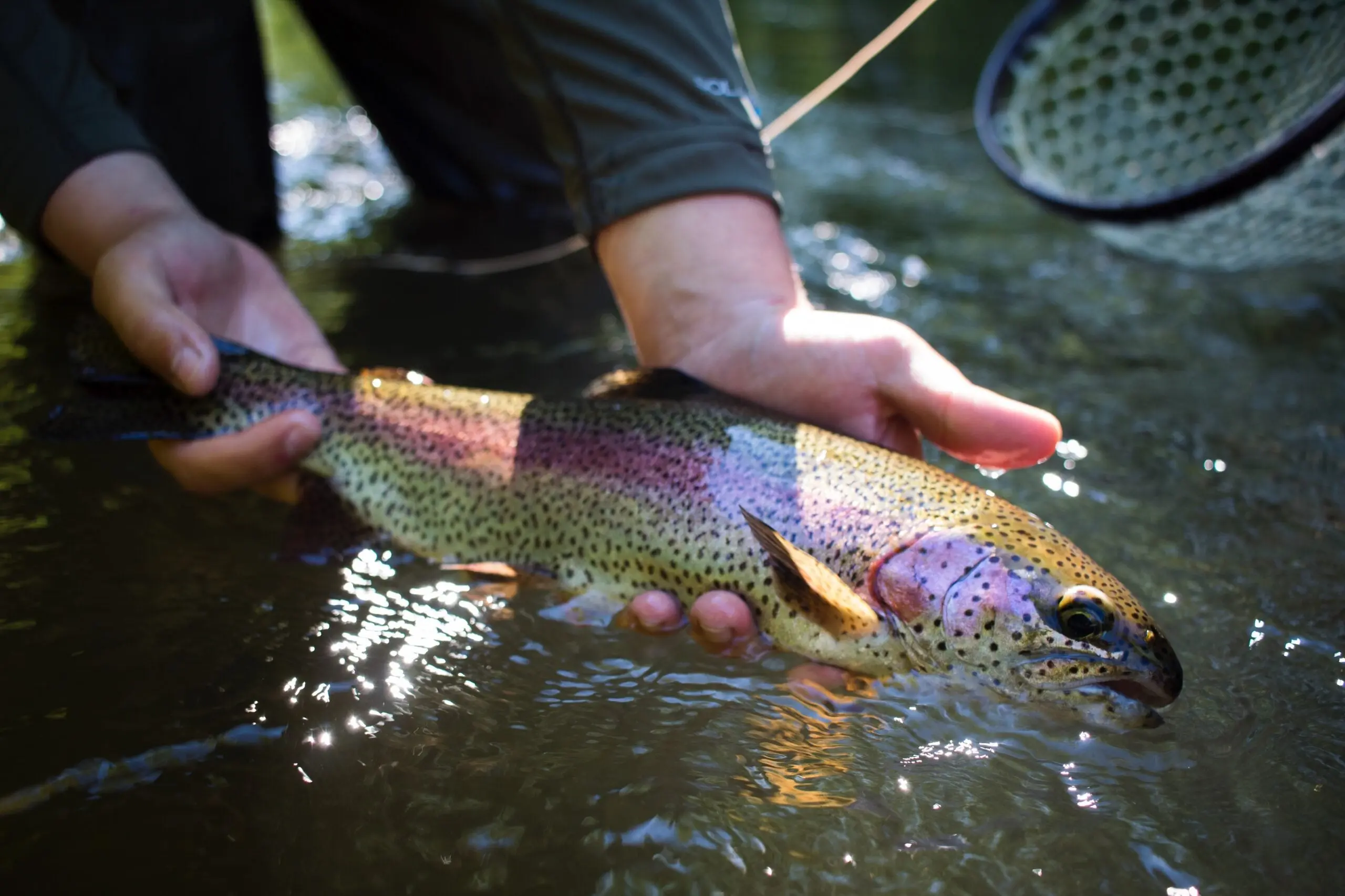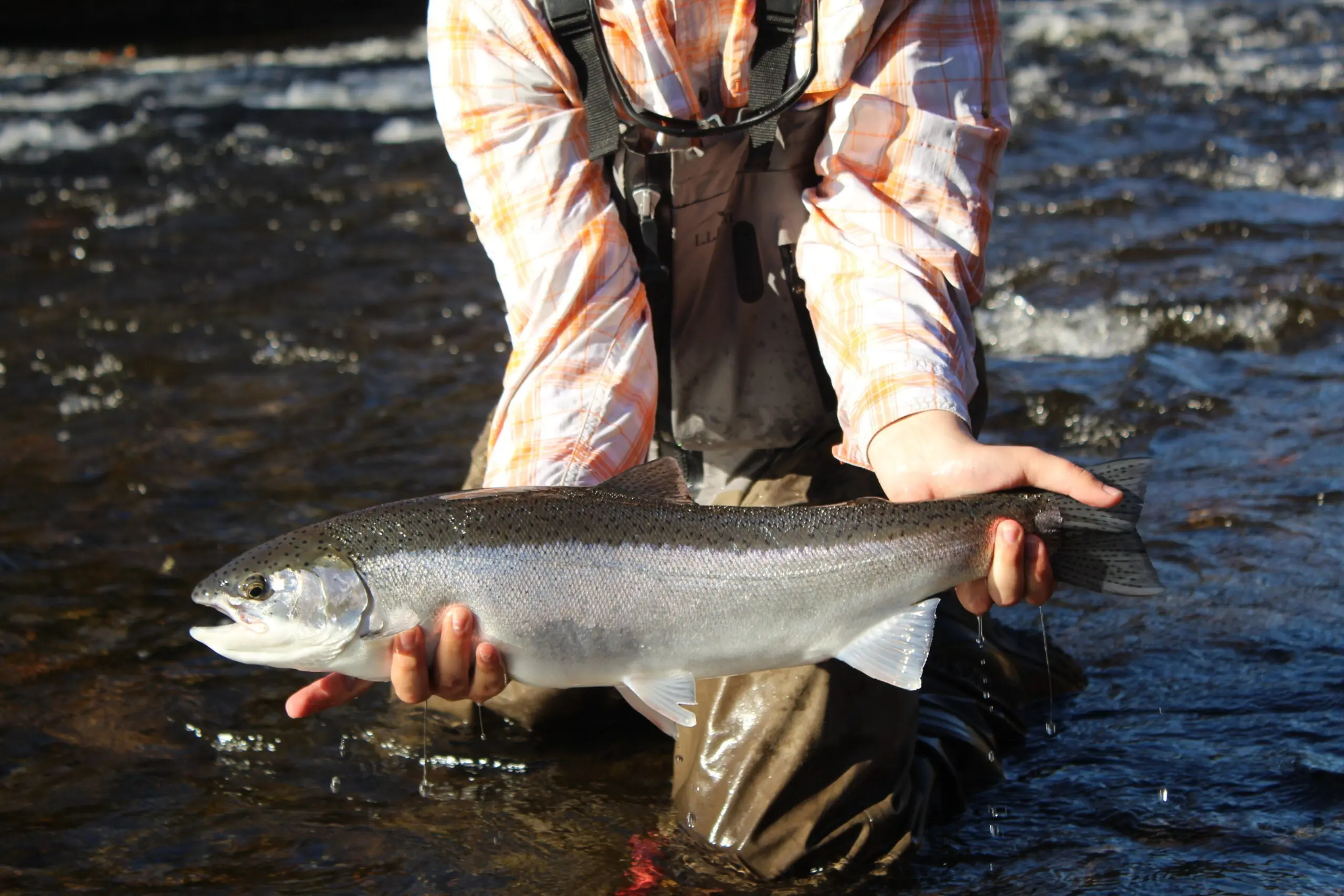While native to Western North America, rainbow trout have become one of the most popular freshwater gamefish around the globe through stocking programs. They are coveted by both conventional and fly anglers for their beautiful colors, aggressive behavior, and potential to grow to large sizes. Whether young or old, experienced or a beginner, rainbow trout have something to offer every type of angler.
From giant Alaskan bows to PNW wild steelhead to New Jersey stockies
, the diversity and accessibility of the species are what make rainbows so much fun to target. Below is a beginner’s guide to rainbows, including an overview of identification, biology, and habitat. Plus, fishing tips for targeting bows in lakes, streams, and coastal rivers. Here are the basics you need to know in order to start catching rainbow trout.

An angler releases a wild PA rainbow trout. Ryan Chelius
Appearance and Biology
Rainbow trout are part of the larger salmonid family, which also includes brown trout
, and other various salmon species. Rainbows, however, have dark green backs, light underbellies, and dark spots. They get their name from a distinct red or pink stripe running their body length, which resembles a rainbow. Depending on location, rainbows range in size, with average fish between 10 and 16 inches. Larger fish can grow upwards of 20 to 25 inches, with true giants reaching 30 inches.
Biology-wise, rainbow trout require cold water to thrive, with 70 degrees being the upper limit of what they can survive in. Like other trout, their diet consists of invertebrates, small fish, and the occasional rodent. Rainbow trout can also tolerate both fresh and saltwater environments. Select rainbows that move out into saltwater are known as steelhead, which eventually make their way back into the rivers to spawn.
Rainbow Trout: History and Habitat
Rainbow trout are native to Western North America, with populations ranging from southern California to Alaska. While they are still present in their native ranges, stocking efforts have made rainbows one of the most widely found trout species. They are now on every continent, with the exception of Antarctica. Rainbows, like other trout, require cold and clean water. Their habitats include rivers, streams, and lakes, but warm summer temperatures pose a big risk to fish survival.
Along coastal regions like the Pacific Northwest, some rainbow trout also call the ocean home. These fish are known as steelhead. While genetically identical to rainbows, steelhead behave differently. They spend most of their time in the ocean foraging on baitfish and growing to impressive sizes. When it is time to spawn, these fish return to the rivers, where anglers are waiting for a chance to hook one. After spawning, these fish return to the ocean and normally live a lifespan of 4 to 7 years.

Rainbow trout are easily identified by a colorful red or pink line across their body. Max Inchausti
Rainbow Trout Fishing: Tips and Tactics
If you’ve fished for trout, chances are you’ve encountered a rainbow. If you haven’t fished for trout, you should. Their impressive colors, powerful fights, and tendency to jump make them an all-around gamefish. Here’s how to target rainbows in their three types of habitat with both conventional and fly tackle.
Rivers and Streams
Rainbow trout are synonymous with stream fishing. While wild populations are found throughout the US, rainbows are the most widely stocked trout species. To catch rainbows, start by targeting cold-water rivers and streams. If your state stocks rainbows, look for a list of approved trout water bodies to narrow down the options. On the water, target current breaks, pools, and deep riffles where trout will wait and ambush their food.
Once you know where to fish, it’s time to get your gear in order. Anglers fishing with spinning tackle typically fish small spinners or jerkbaits
. The erratic movement mimics a fleeing baitfish and will attract the attention of a rainbow. Cast these downstream at a 45-degree angle with a slow retrieve. The combination of current and the retrieve will create movement that trout can’t resist. If you prefer live bait, it’s hard to beat a nightcrawler. Rigged on a small bait hook and drifted under a bobber, this rig can be lethal. Cast it above likely holding places, let the bait drift through, and wait for the bobber to shoot under.
For fly anglers, the options are just about endless. Small nymphs
like a walts worm drifted under an indicator setup will consistently fool rainbows. Streamers like wooly buggers and large wet flies can be swung and stripped through likely areas to elicit a strike. When bugs are coming off the water, and fish are looking up, throw dry flies. Matching the fly to the bugs on the water will increase strikes. Look for rising fish and position your fly above them and in their feeding lane. Wait for the fish to eat the fly and set the hook.
Stillwater
Plenty of lakes and reservoirs hold healthy rainbow trout populations. Large water bodies mean trout can spread out, and locating fish can be challenging. The key to successfully fishing stillwater is learning to read the water
. Areas like ledges, points, and underwater streambeds act as structure. This structure will attract fish looking for current breaks and ambush points.
Once you’ve narrowed down areas that will hold fish, there are two main ways to target rainbow trout: with lures and live bait or with an indicator rig. For conventional anglers, the same spinners, jerkbaits, and live bait used in streams are all effective. Cast in a fan motion, covering a wide range of water in front of you before moving spots to hit all likely areas.
Fly anglers almost always target stillwater rainbows with an indicator rig. The overall setup is similar to what you use on a stream, but you’re fishing without current. Anglers should use leech and chironomid patterns, mimicking the most common bug life in these systems. Cast the rig out and occasionally twitch the flies, creating a movement to attract cruising rainbow trout.
Steelhead
is the epitome of trout fishing. These fish are known for epic fights and live in wild places. Most steelhead fishing takes place in the Pacific Northwest in large coastal rivers. Healthy populations of stocked steelhead, originally transplanted from western populations, are also found in the Great Lakes region
.
The two most common techniques to target steelhead are center pin fishing and swinging flies. Center pin fishing is designed for long, drag-free drifts under a float. A center pin reel has no drag. This creates a free spool effect and near-perfect drifts with a float. Typical lures include bead rigs and egg sacs to mimic free-floating eggs that steelhead key in on.

An angler holds up a fresh steelhead caught in Pulaski, New York. Ryan Chelius
Swinging flies is a technique involving two-handed spey or switch rods and long casts. The idea is to use a heavy shooting head to send casts across the river and swing a fly through the current until a steelhead grabs it. Unfortunately, wild steelhead are few and far between, and it can take thousands of casts to get a grab. Regardless, the strike of a steelhead on a swung fly is one of the most exhilarating experiences in all of fly fishing.
On the other side of the country, the Great Lakes offer exceptional steelhead fishing. While these fish are not true saltwater steelhead, behaviorally, they act the same. They spend much of their life in the Great Lakes foraging for bait fish until they return to various tributaries to spawn. Unlike their PNW counterparts, these fish are much more abundant and willing to eat. The same techniques work to target these Great Lakes fish, with a multi-fish day being fairly common.


